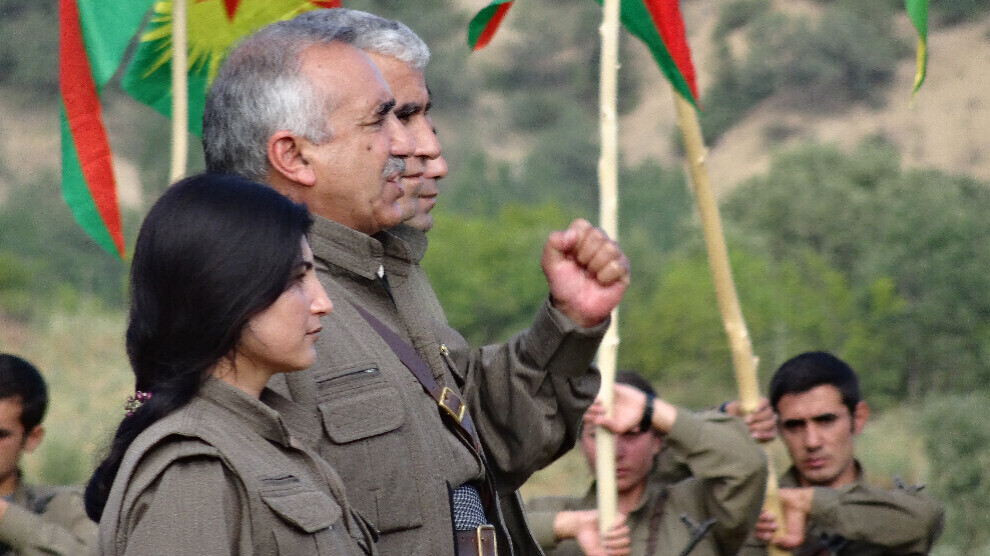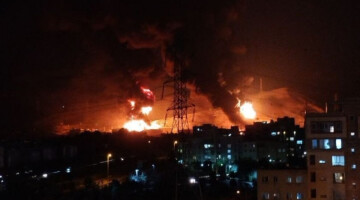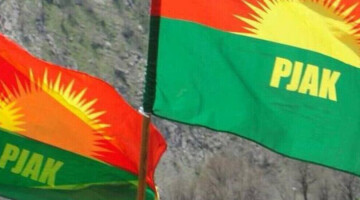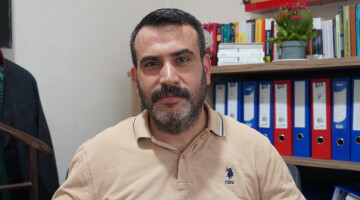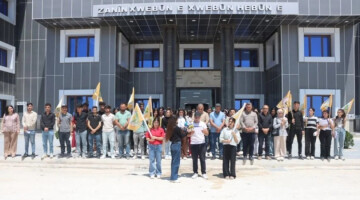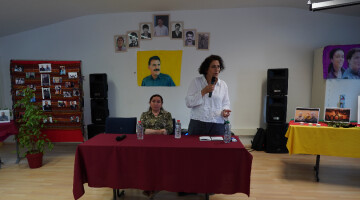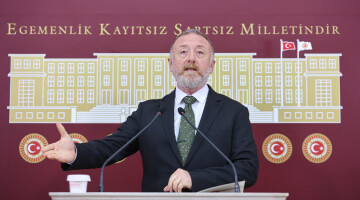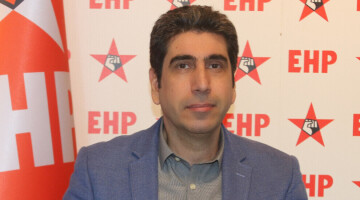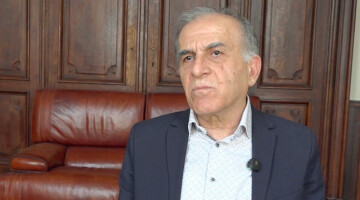Murat Karayilan, a commander of the Central Headquarters of the People's Defence Forces, gave an extensive ANF interview on the development of the guerrillas since the beginning of the armed struggle on 15 August 1984. We publish an excerpt.
What constitutes the modern guerrilla struggle today?
Regarding your question, to which there is a very comprehensive answer, I can briefly say the following. In the last 50 years there have been very important developments in the field of science and technology. Space exploration has advanced and the Global Positioning System (GPS) was discovered. In other words, it became possible to determine the coordinates of a place anywhere in the world. The missile system aimed at a specific coordinate, inventions such as unmanned aerial vehicles, the advanced use of laser beam technology and thermal technology in warfare and the level reached by the massively developing means of communication have radically changed our world in every respect.
Our leadership considered this scientific and technological process, which began after the Second World War, as a revolutionary process. This situation required a significant change in the theories and instruments of warfare. Although some basic rules and principles in war have not changed, most of the old strategies and tactics have become meaningless and have changed radically. Especially in the last 10 to 15 years, the dramatic impact of these new inventions on the battlefield has accelerated this radical change. Today, warfare has reached a level where it is conducted on the basis of intelligence. In fact, war is now waged using intelligence, technical and specialised methods of warfare. Normal classical wars have now been overcome. Normal classical weapons and armies no longer play a major role. Despite all this, the human factor is still the most important factor in war, and the decisive factor in war is still the human factor. In other words, human capabilities, the ability of people to achieve good results in warfare, have evolved. From a simple point of view, one might think that intelligence technology is now decisive in war and other things are secondary, but this does not correspond to reality. In war, human will, human intellect and human capabilities have become increasingly decisive. When one considers that intelligence is useless without creative evaluation and that technology cannot be used without expertise and experience, it becomes clear that human capability is paramount.
Rêber Apo [Abdullah Öcalan] said many years ago that the greatest technology is man. His philosophy essentially focuses on human reality. In other words, the Apoist philosophy and style of education focuses mainly on the human phenomenon. Therefore, the place where human capabilities, human intellect, will, courage and sacrifice are most concentrated is in the ranks of the PKK. In the new period, the guerrilla is mainly based on this. The power of the paradigm of democratic modernity, which enabled the Kurdish guerrillas to read the process correctly, and to adapt early to the rapidly developing technology and its radical changes in the reality of war.
Were there not shortcomings in this respect?
Undoubtedly there were. There were also delays. This led to heavy losses, but also to unrest and difficulties. We cannot say that everything developed in a perfect way. The guerrillas managed to achieve their true strength with the philosophy of Rêber Apo by struggling with difficulties. In this regard, the restructuring projects it developed one after the other had a great impact in particular. Especially for 2018, it can be said that the restructuring project, which envisages a very comprehensive and radical change in the guerrilla in every aspect, achieved a great transformation. This project focused more on human capabilities and the reality of war. It aimed to create a guerrilla of democratic modernity parallel to the paradigm of Rêber Apo's democratic modernity. In this way, the new period had to change most of the war tactics established by Mao Zedong in China. The guerrilla war being waged in Kurdistan today has inherited much of the roots on which its tactics are essentially based, but it has also radically renewed much. What is being fought against most are the old habits of the classical guerrilla. In this context, it has even been stated that our greatest enemy is our own habits. In other words, an attempt has been made to create the guerrilla of the modern era, based as much on the struggle with oneself as on the struggle against the enemy.
The new guerrilla has been created by the martyrs
Of course, this level has developed on the basis of great heroism and the martyrs. The concentration, struggle and work of many leading commanders, from Delal Amed to Atakan Mahir and Ali Piling, have played a big part in this change. For these heroines and heroes are also pioneers who have tried to understand Rêber Apo properly at the intellectual level, who have tried to read the process properly and who have fallen in applying it in practice. In this sense, they were the creators of the guerrilla of the modern era, the guerrilla of the 21st century.
Of course, this project was first about conviction and the determination to grasp the age; it focused on the reality of becoming a party and placed great emphasis on clarifying ideology. Then it focused on military art and military culture. Thirdly, the branch system emerged on the basis of war technology; specialisation takes place on this basis. In other words, on the basis of party organisation, militancy and specialisation, this project aimed at the framework that we call professional guerrilla. This could only be achieved by fighting against the classical guerrilla style.
With the right kind of movement and deployment, the intelligence gained through modern technology and today's means of air warfare were to be thwarted. Tactics of above and below ground warfare were developed, exploiting the terrain in breadth and depth. Ultimately, a new, modern, professional guerrilla emerged in Kurdistan that completely surpassed the old classical guerrilla. On this basis, it created the ability to use the terrain in depth and breadth against the largest army formations equipped with all the technology of the time and to defeat the enemy with its high manoeuvrability. It has proven to be an invincible force against these technological attacks.
Our struggle is at the peak of its development
This great resistance is a result of shaping the 21st century guerrilla in Kurdistan as a result of the paradigmatic intensification based on the martyrs. In the 39th year of the glorious breakthrough of 15 August [1984; beginning of the armed struggle], we can proudly express this level that the guerrilla has reached today thanks to the work of Rêber Apo and the epic resistance of our martyrs. Of course, this is not easy, but only possible with a lot of effort, intensity and depth. It could only develop through the activation of human talent at the highest level. This is how the reality of an invincible guerrilla army emerged, which is based on self-discipline, conspiracy and camouflage and can be almost invisible on this basis, which can be used underground and above ground in the most creative way, like a ghost army, which makes the best use of the technology at its disposal, which has tactical creativity, which can fight bravely and courageously and which is ready to sacrifice itself for its cause without hesitation. Today, the Kurdish guerrillas are experiencing a peak of sacrifice.
The Kurdish guerrillas are also experiencing a similar peak of tactical creativity today. In this respect, it has reached a very advanced level. The perspective of revolutionary people's war is being creatively put into practice. In this respect, it is a high point. It is also clear that our struggle will lead to the collapse of the AKP/MHP regime, a regime that represents the fascist mentality in Turkey, if the resistance that is developing today succeeds. In fact, the regime wants to build its existence on the liquidation of the guerrilla or freedom movement as a whole. For this reason, it calls this process a "war to the death". Therefore, if the guerrillas prove their invincibility in the face of this, it means the complete collapse of this regime. In this sense, it is clear that our struggle is at its peak. The 39th year of our armed struggle is an important year for us, the Kurdistan Freedom Guerrilla. In this way, we have entered a process in which Rêber Apo and the March for the Freedom of Kurdistan will be more on the agenda. In the end, however, the modern guerrilla is not only a phenomenon related to Kurdistan. The tactical expansion developed by the guerrilla, based on a paradigm that will have global repercussions, also points to a new path and method of resistance for all of humanity.
Some say that the time of guerrilla struggle is over. How would you explain guerrilla struggle, considering it both as a way of life and as a paradigmatic approach?
In revolutionary processes, there have always been those who threw in the towel early and sought justification for surrender. Such an understanding can also arise in this period. Those who say that the era of the guerrilla is over are those who want to pave the way to condemn societies to surrender to the ruling hegemonic powers. That's right, the era of the classical guerrilla is over. That era is over. But not only for the guerrilla, but for everything that is classical today in all areas of life, the time is over. In other words, everything has changed. Any phenomenon that is not adapted to the realities of the time is also outdated. For example, classical regular armies are also obsolete. Classical armies based on the old system can no longer exist in war. This is also true for guerrillas. In other words, social dynamics and means are in a constant state of change according to the laws of dialectics. According to this law, things of the past have naturally become obsolete. Again, the guerrilla perspective, conceived according to a classical left perspective, may be obsolete, but according to the paradigm of democratic modernity, the guerrilla that perfects itself is a guerrilla adapted to the times.
The renewal of the guerrilla, its adaptation to the times and the present, not only in terms of its qualities and tactics, but also in terms of its role in the revolution, has been positioned according to the conditions of the time. For example, in the paradigm of democratic modernity, as in the perspective of the long people's war, not everything is guerrilla. First of all, the role of organised violence is not everything. It is about finding a position that takes into account the increasing importance of social forces and the power of public opinion. Here, the guerrilla as a defensive force is a force that gives confidence to society, a force that society relies on. It plays a vanguard role as a force that gives courage and strength to society and intervenes when there is a blockage. In other words: in democratic modernity, guerrilla is also considered important, but not everything is guerrilla. The main source of the power of revolution is society itself. Revolution is the work of the masses. The revolution can be based on three pillars that emerge from or are organised in society, and on this basis, it succeeds in becoming a power.
Three pillars of the revolution
The first pillar is the organised mass of people, i.e. organised society. We see this today; in Iraq, for example, organised power can change everything. So, the power of society is essential; it comes first.
The second is the guerrilla as an organised, armed and professional defence unit. According to the needs of the moment, it is very active or acts in a more balanced way and opens the way to the social sphere. It takes shape according to the respective developments.
The third is self-defence, which is half civilian and half military and is organised secretly within society, a kind of secret army. In the current phase, other organised structures of the revolution, based on this revolutionary perspective, will both ease the burden of the guerrilla and enable the guerrilla to play its role.
In the new phase, the guerrilla can no longer go in and out everywhere. It is necessary to reassess the entire terrain as a field of action. For example, high alpine and bare areas, where the guerrillas can easily become targets, must be assessed in the same way as lowland areas. In terms of modern air reconnaissance, bare areas, even if mountainous, must be considered as a kind of plain. In such areas, the guerrilla must be able to operate clandestinely, underground and mobile, relying on a solid mass base. It can be based anywhere, not just on the mountain. What is important here is that the guerrilla of the modern era no longer operates with large troops as in the past, but with teams based on expertise. We call this coordinated team warfare. Depending on the need, the teams act alone or simultaneously. Guerrilla teams based on conspiracy, stealth and discipline are almost like ghosts, appearing wherever they want and never being found. They can play a strong defensive role in society and be a source of strength.
The guerrilla must rely on society
So, in summary, we can say the following: in the new era, the classic guerrilla can no longer exist. It must be qualified and trained. The guerrilla fighters are not ordinary soldiers. They have to be professionals. It is impossible to create revolutionary developments in our age without the guerrilla taking the lead in the revolution, giving strength and enthusiasm to society with its lifestyle and resistance, and guiding it with its attitude.
So it is about a changing reality, not the ordinary, classic guerrilla, but a guerrilla that relies on society and has an improved style of movement and modern fighting ability. It is as important for the guerrilla to be based on society as it is to be based on the depth and breadth of the terrain. Guerrilla and society, society and self-defence, self-defence and guerrilla must be organisations that feed and support each other, like a triple circle. If properly organised and equipped with the necessary qualities, they will naturally nourish, protect and support each other. Only forces that can unfold in this way are able to carry out revolutionary processes today. Those who cannot achieve this, who limit themselves to bourgeois-democratic methods of struggle, leave themselves at the mercy of fascism. In other words, fascism can come whenever it wants, storm all institutions and arrest everyone; it already has at its disposal intense instruments of psychological warfare and can impose what it wants through intimidation of society. In other words, the democratic social dynamics of society are important here. One of the most important factors that actually maintain this democratic social dynamic is the guerrilla as a self-defence force that gives society strength, courage and morale.
In a society where there is a guerrilla that is constantly nurtured and supported, the enemy cannot achieve results because there is an organised defence force that does not leave the people alone and gives them strength and morale. The guerrilla fills the gap in society's self-defence and plays the role of a catalyst for the development of social movements. In modern times, the role of the guerrilla in the revolution must develop in this way.
The guerrillas in Kurdistan are the best example of this, both with the ideological paradigmatic stance they take and the model they show and represent in terms of women's freedom. If the formation of women like Bêrîvan, Zîlan, Sara, Sema, Çiçek, Delal and Şîlan had not emerged in the ranks of the guerrillas, the liberal understanding of women in Kurdish society would not have been able to appear so confidently and courageously. In this way, the social revolution would not have come about so quickly. Kurdish women have developed into a dynamic force. They have rapidly gained influence in defence as well as in politics and in all areas of social life and are considered a role model worldwide. This development is based on the pioneering work of women in the guerrillas. The same applies to society in general. In this respect, the freedom guerrillas of Kurdistan are today the flag bearers of democracy, women's freedom and social freedom. Colonialism wanted to make Kurdistan the centre of reaction. That was the aim. If Kurdistan today is a centre of progress, democracy and freedom with this struggle, the role of the guerrilla in this cannot be ignored in any way.
Moreover, the guerrilla today is a big obstacle for the development of fascism and occupation, not only in Kurdistan, but in the whole Middle East. In this respect, the struggle that the guerrilla is waging today is a struggle for democracy in Turkey. The guerrilla is paving the way for raising the flag of democratic socialism. In this way, it plays a fundamental role in creating a basis of struggle on which all democratic socialist forces can stand. At the same time, with the perspective of the democratic nation, there is already a framework that mirrors this for other peoples.
The Kurdish freedom guerrillas are putting up great resistance in South Kurdistan and are not letting the invaders pass. Can free areas that are not part of the Medya Defense Zones be defended with the guerrilla method against the technology of our time?
The struggle that is being waged today in the Medya Defense Zones is a very serious example of the defence of free areas. As for defending free areas against the technology of our time, of course the people you mentioned in your previous question will say: "You can't defend that." South Kurdistan has been under attack for four years. Although the second largest NATO army uses international forces, local collaborators, traitors and banned weapons, and has intensified its attacks in the last two years, it has not yet succeeded in taking South Kurdistan. If it turns to Rojava or other places tomorrow, the struggle that is organised with the perspective of the revolutionary people's war and integrates the resistance into society will definitely win. Then it will become visible that in our era it is possible to defend free territories against hegemonic powers with all kinds of technology. In this respect, an important test is being passed now, and we believe that this test will end successfully. The guerrilla of the 21st century will prove its invincibility in this process.

